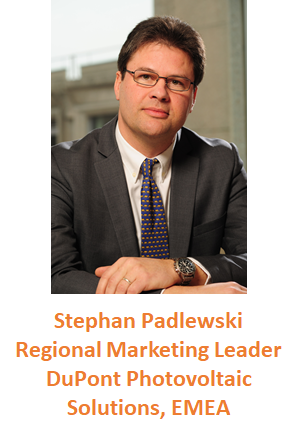In the AFSIA’s “Who’s Who” series we ask a few questions to individuals who are shaping the industry. This month we ask Stephan Padlewski about his career and most notable moments of his career.
1. What is your role at your company and what does this entail?
I currently lead the marketing and business development activities at DuPont Photovoltaic Solutions, in EMEA. DuPont operates upstream in the PV value chain, serving the market at the material level, and is engaged with many manufacturers of PV cells, panels and upstream material converters. In Africa, the PV market is mostly downstream with limited panel or materials manufacturing capacity. At DuPont, we have been surveying ageing assets since 2011, with the aim of correlating early signs of degradation affecting the panels with the design of the panels, and the materials used by manufacturers. We have gathered 2 GW of data to-date, which helps provide risk mitigation recommendations to project developers and investors – with best practices on panel selection for their new projects. We also have developed the capability to conduct plant level “Bill-of-Health” checks to assess their actual performance and what may need to be done to optimize the power output. To minimize the LCOE, the PV industry expects the system and all components to operate for a very long period of time, 25 years today and even 30 years for certain projects. We already know that many plants will not be able to perform well for such a long period of time, particularly for PV systems deployed in harsh climatic environments, such as those found on the African continent. This challenge will also affect the Africa region, so our engagement is to primarily bring design and operational best practices derived from other more mature solar market to help mitigate risks.
2. How did you start your journey in the solar industry?
My first experience with the potential of PV dates back to my college years, toward the end the 70s. I was then an enthusiastic science student, enjoying math equations, calculus and even programming. Back then electronic calculators were allowed during math and physics exams, and I was one of the few who had selected the less fancy, but a more robust device powered by a small PV cell. Unlike most other students equipped with battery powered devices, my calculator never failed me during exams – this was my first direct experience with the reliability of PV. Down the road and after studying more advanced physics, semiconductor technologies and the related photovoltaics technologies, as a graduate student, I reconnected with the world of PV and industry toward the mid 2000 – by developing 3 rooftop PV systems in south west France with a few friends. All these systems are still operational, and keep producing very well. I then joined the DuPont Photovoltaic Solutions group in 2008 and have since been enjoying this industry as a direct participant.
3. Tell us about your most memorable moment in solar
I have over my carrier been involved in different industries, electronics with PCB and IC packaging, then flat panel displays with the OLED technology. All were also characterized by a relatively rapid pace of evolution, exposed to fast and competitive market environments. However, none of these have so rapidly developed in only 2 decades. In the early ‘00s. PV was a small emerging industry in Europe (Germany), supported by substantial government subsidies (FiTs), then merely a “curiosity” and very limited market reach. What a journey since then. After 2 decades, it is today a global industry, with one of the most cost competitive positions in the energy sector, best positioned to also address effectively our most critical environmental challenges, with a technology platform that can provide a cost effective energy wherever the sun shines, and with the lowest carbon footprint over its operational lifetime. From a technology standpoint, it is quite remarkable how fast panels have evolved from a 13% conversion efficiency to over 23%, with PV cells that can also convert indirect albedo irradiation on the back of the panels to additional power generation. So rather than a particular moment, I have continuously been amazed by the consistent transformation of this industry, and its potential to further positively impact our world in the future. With the PV market now also firmly established on the African continent it falls to us all to help accelerate its adoption, as the opportunity is seemingly endless.



